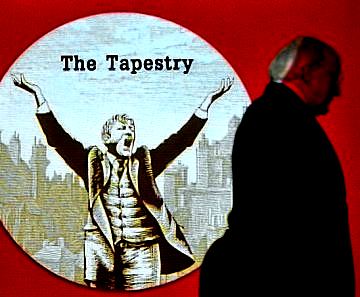Dublin: 1913 remembered on Tapestry
Proud to have inspired others to embroider their stories
Soon after the Prestonpans Tapestry was completed arts friends from Ireland enquired how we'd set about it all. And just as Alexander MacCall-Smith was inspired to create the Great History of Scotland so too in Dublin local artists are commemorating the Dublin Lockout in 1913.
Kitty Holland reports: Irish Republic President Michael D Higgins has unveiled the first pieces in a new tapestry to commemorate the 1913 Dublin lockout. The 1913 Lockout Tapestry, commissioned by Siptu, is expected to be complete in time for the anniversary of the start of the seminal strike, in August next year, the centennial.
Some 20,000 Dublin workers went out on strike in Dublin, between August 1913 and January 1914, in what is regarded as the most severe and significant industrial dispute in the history of the State. A central point to the workers’ demands was the right to organise into trade unions.
Painters Cathy Henderson and Robert Ballagh will work with the National College of Art and Design to create a visual narrative over 30 panels, measuring 2ft by 2.5ft each, telling the story of the dispute. They will be stitched by community and voluntary groups.

The President, in his address yesterday, said it was particularly apt that the project was a collaborative one.
“It was through the power of collective action that the workers of the Irish Transport and General Workers’ Union sought to establish their right to organise to secure a better deal for the ordinary workers of Dublin.
“The Lockout fits awkwardly into the mainstream narrative of Irish history. Whilst the workers involved were generally nationalists, so too were many employers, including William Martin Murphy.
“The strikers’ greatest ally was the British Trades Union Congress, without whose aid the strike could not have been sustained.”

Published Date: November 8th 2012
|





